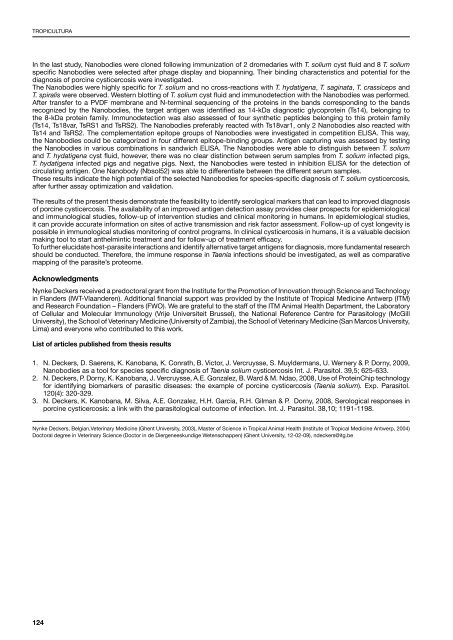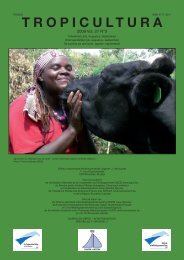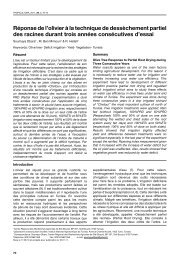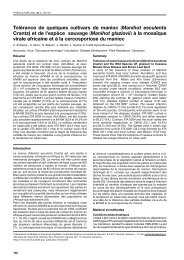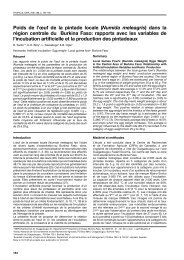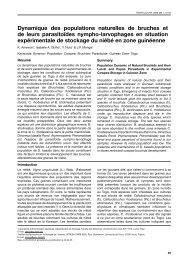Fascicule entier - Tropicultura
Fascicule entier - Tropicultura
Fascicule entier - Tropicultura
You also want an ePaper? Increase the reach of your titles
YUMPU automatically turns print PDFs into web optimized ePapers that Google loves.
TROPICULTURA<br />
In the last study, Nanobodies were cloned following immunization of 2 dromedaries with T. solium cyst fluid and 8 T. solium<br />
specific Nanobodies were selected after phage display and biopanning. Their binding characteristics and potential for the<br />
diagnosis of porcine cysticercosis were investigated.<br />
The Nanobodies were highly specific for T. solium and no cross-reactions with T. hydatigena, T. saginata, T. crassiceps and<br />
T. spiralis were observed. Western blotting of T. solium cyst fluid and immunodetection with the Nanobodies was performed.<br />
After transfer to a PVDF membrane and N-terminal sequencing of the proteins in the bands corresponding to the bands<br />
recognized by the Nanobodies, the target antigen was identified as 14-kDa diagnostic glycoprotein (Ts14), belonging to<br />
the 8-kDa protein family. Immunodetection was also assessed of four synthetic peptides belonging to this protein family<br />
(Ts14, Ts18var, TsRS1 and TsRS2). The Nanobodies preferably reacted with Ts18var1, only 2 Nanobodies also reacted with<br />
Ts14 and TsRS2. The complementation epitope groups of Nanobodies were investigated in competition ELISA. This way,<br />
the Nanobodies could be categorized in four different epitope-binding groups. Antigen capturing was assessed by testing<br />
the Nanobodies in various combinations in sandwich ELISA. The Nanobodies were able to distinguish between T. solium<br />
and T. hydatigena cyst fluid, however, there was no clear distinction between serum samples from T. solium infected pigs,<br />
T. hydatigena infected pigs and negative pigs. Next, the Nanobodies were tested in inhibition ELISA for the detection of<br />
circulating antigen. One Nanobody (Nbsol52) was able to differentiate between the different serum samples.<br />
These results indicate the high potential of the selected Nanobodies for species-specific diagnosis of T. solium cysticercosis,<br />
after further assay optimization and validation.<br />
The results of the present thesis demonstrate the feasibility to identify serological markers that can lead to improved diagnosis<br />
of porcine cysticercosis. The availability of an improved antigen detection assay provides clear prospects for epidemiological<br />
and immunological studies, follow-up of intervention studies and clinical monitoring in humans. In epidemiological studies,<br />
it can provide accurate information on sites of active transmission and risk factor assessment. Follow-up of cyst longevity is<br />
possible in immunological studies monitoring of control programs. In clinical cysticercosis in humans, it is a valuable decision<br />
making tool to start anthelmintic treatment and for follow-up of treatment efficacy.<br />
To further elucidate host-parasite interactions and identify alternative target antigens for diagnosis, more fundamental research<br />
should be conducted. Therefore, the immune response in Taenia infections should be investigated, as well as comparative<br />
mapping of the parasite’s proteome.<br />
Acknowledgments<br />
Nynke Deckers received a predoctoral grant from the Institute for the Promotion of Innovation through Science and Technology<br />
in Flanders (IWT-Vlaanderen). Additional financial support was provided by the Institute of Tropical Medicine Antwerp (ITM)<br />
and Research Foundation – Flanders (FWO). We are grateful to the staff of the ITM Animal Health Department, the Laboratory<br />
of Cellular and Molecular Immunology (Vrije Universiteit Brussel), the National Reference Centre for Parasitology (McGill<br />
University), the School of Veterinary Medicine (University of Zambia), the School of Veterinary Medicine (San Marcos University,<br />
Lima) and everyone who contributed to this work.<br />
List of articles published from thesis results<br />
1. N. Deckers, D. Saerens, K. Kanobana, K. Conrath, B. Victor, J. Vercruysse, S. Muyldermans, U. Wernery & P. Dorny, 2009,<br />
Nanobodies as a tool for species specific diagnosis of Taenia solium cysticercosis Int. J. Parasitol. 39,5; 625-633.<br />
2. N. Deckers, P. Dorny, K. Kanobana, J. Vercruysse, A.E. Gonzalez, B. Ward & M. Ndao, 2008, Use of ProteinChip technology<br />
for identifying biomarkers of parasitic diseases: the example of porcine cysticercosis (Taenia solium). Exp. Parasitol.<br />
120(4): 320-329.<br />
3. N. Deckers, K. Kanobana, M. Silva, A.E. Gonzalez, H.H. Garcia, R.H. Gilman & P. Dorny, 2008, Serological responses in<br />
porcine cysticercosis: a link with the parasitological outcome of infection. Int. J. Parasitol. 38,10; 1191-1198.<br />
Nynke Deckers, Belgian,Veterinary Medicine (Ghent University, 2003), Master of Science in Tropical Animal Health (Institute of Tropical Medicine Antwerp, 2004)<br />
Doctoral degree in Veterinary Science (Doctor in de Diergeneeskundige Wetenschappen) (Ghent University, 12-02-09), ndeckers@itg.be<br />
124


